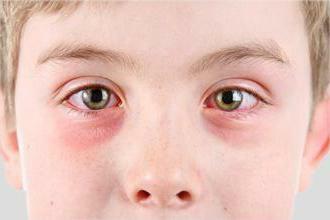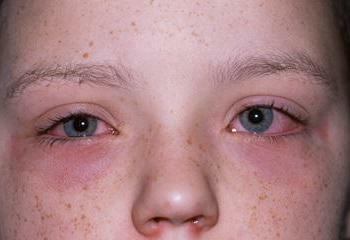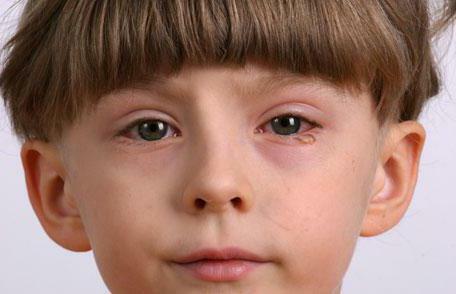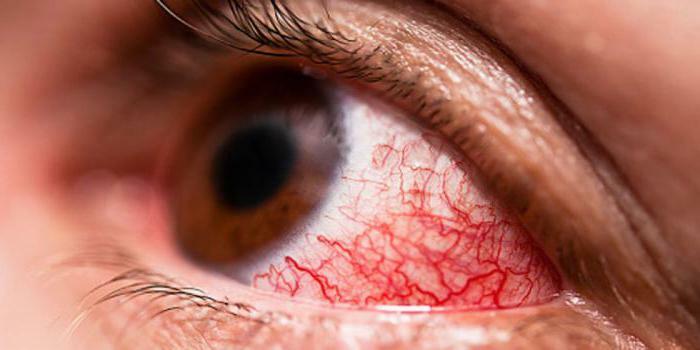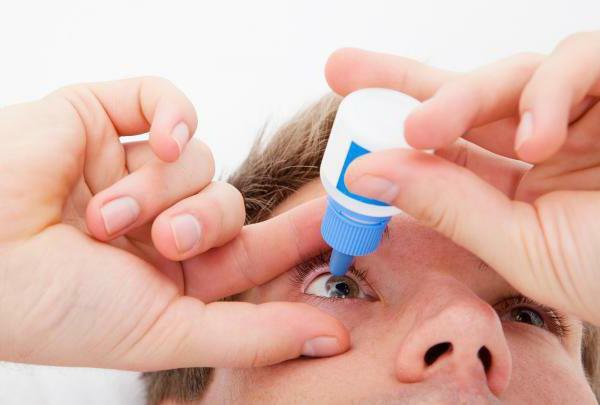Bacterial conjunctivitis in children: treatment and symptoms
Conjunctivitis is an inflammation of the eye's mucous membrane - a conjunctiva that causes various infections, viruses and allergens. We will understand how bacterial conjunctivitis manifests in children. Treatment will also be described in detail in this article.
Conjunctivities and features of the conjunctiva
Conjunctiva is a thin mucous tissue that covers the anterior part of the eye and the inner surface of both eyelids, forming an original pocket on the upper and lower arch. A large number of glands in the tissues around the eyes produce a lacrimal fluid and a special protein compound - mucin. Together they form a strong protective and moisturizing tear-like environment, which provides the eyeball with visual ability and mobility.
Despite the relative fineness, the conjunctiva is a complex multilayered organic tissue that transforms into the corneal epithelium. Vessels of eyelids and eyelashes carry blood supply to the conjunctiva, the network of lymphatic vessels forms a layer of protective lymphoid tissue, tear and eye nerves provide the shell with high sensitivity. Thus, not only the state of the eyes, but also the visual acuity depend on the normal composition and functioning of all components of the conjunctive tissue. Therefore, bacterial conjunctivitis is so dangerous. Symptoms and treatment in children require special attention.
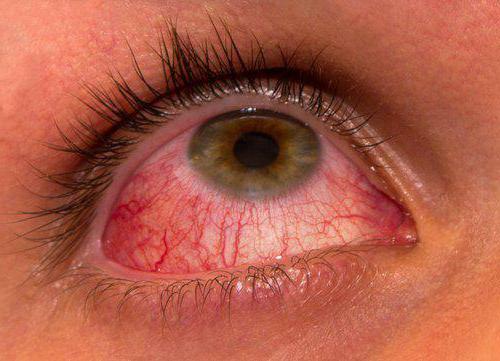
Conjunctiva is the first protective barrier to the eyes and the most vulnerable part for the effects of various external irritants, bacteria and allergens.
In addition, the nasolacrimal canal not only sheds a teardrop that absorbs dust and bacteria from the air, but also triggers a reverse process, when infection, viruses or allergic pathogens rise into the eyeball and irritate the conjunctiva from within. There is bacterial conjunctivitis( photos in children manifestations of this disease you see in our article).
It is useful to know that during a seasonal viral epidemic or in contact with patients with dangerous viral infections( eg measles or rubella), the protective mask does not help, because the viruses freely penetrate the body through the nasolacrimal canal through the eyes.
Symptoms of conjunctivitis
So, how is bacterial conjunctivitis manifested in children? Treatment is selected depending on the symptoms.
In a normal healthy state, the conjunctiva provides the eye with sufficient moisture, freedom of movement in the tear pocket, puts a transparent protective barrier that does not reduce the visual and light-sensing ability of the eye.
In the case when the eyes begin to itch, burning, increased tearing, on the surface of the cornea protrudes the grid of dilated blood vessels, foreign inclusions and soreness are felt during eye movement, eyelids or skin around the eyes swell, it can be concluded that the inflammatoryprocesses. Conjunctivitis is the most common disease that affects the mucous eyes.
Than to treat bacterial conjunctivitis in a child? This question will be considered below.
Kinds of conjunctivitis
Depending on the nature and source of infection, there are three types of conjunctivitis, which require completely different approaches to diagnosis, treatment and prevention.
1. Bacterial conjunctivitis - caused by various bacteria, such as staphylococci, chlamydia, and the like. They fall on the mucous eye as from the external environment with insufficient hygiene, mechanical damage or weakening of the immune functions of the conjunctiva, as well as from the pathogenic microflora of the organism itself during the transfer of infectious diseases. If bacterial conjunctivitis occurs in children, treatment should be directed to the destruction of pathogenic microorganisms.
2. Viral conjunctivitis - affects the conjunctiva against adenovirus and enterovirus infections, influenza, herpes, rubella, chicken pox. Often the viral type of inflammation is accompanied by rhinitis, pharyngitis or a concurrent bacterial form of conjunctivitis.
3. Allergic conjunctivitis accompanies almost all forms of allergic reactions of the body to chemical, food, biological allergens and is a concomitant inflammation in allergic rhinitis, dermatitis and asthma.
Bacterial conjunctivitis in children. Reasons for
Conjunctivitis in children is a very common disease and up to 5 years of age is diagnosed in 30% of all eye pathologies. This is due to the characteristics of the child's body and the immune system, which is actively formed and insufficiently effectively protects the body from the effects of unfavorable factors. Important is the specificity of children's groups and conditions of life.
The high risk of infection on the mucous membrane of the child's eyes, which adds little importance to hygiene and basic health standards, the activity of children during the incubation period, when the ill child continues to communicate with peers and becomes the source of further spread of infection, the psychophysical characteristics of the life of young children are allthis contributes to the frequent occurrence of infectious inflammation, including the eyes. So there is bacterial conjunctivitis in children.
In newborns a special place is occupied by conjunctivitis caused by passing through the mother's birth canal with untreated venereal diseases - gonorrhea or chlamydia. Such a conjunctivitis manifests itself within a few days after birth and can have serious consequences, including blindness and loss of the eye, if the proper treatment is not performed in time.
With age, the indicator of ocular pathologies in children begins to shift toward various refractive disorders, such as myopia, hypermetropia, astigmatism.
Diagnosis of bacterial conjunctivitis in children
The methods of diagnosis, treatment and hygiene of various diseases in children by the well-known pediatrician Evgeny Olegovich Komarovsky are very popular today. His school, which has a television and print version, received wide recognition from the audience and all responsible parents. A simple, understandable, confidential manner of presenting information and the effectiveness of the methods of the famous doctor help raise the conscious and cultural level of the population raising the younger generation.
The scientific approach to explaining the most frequent problems with children's health and the availability of proposed solutions give parents the opportunity to independently study all aspects of complex medical reports and assess the need to seek help from specialists.
Distribution, activity and periods of exacerbation of bacterial conjunctivitis in children is difficult to accurately record, because the frequency of the processes, the relative ease in most cases of getting rid of inflammation, the positive experience of previous treatments - these factors cause a rare appeal to doctors.
Diagnosis depends on how the bacterial conjunctivitis manifests in children. Symptoms can be varied.
It is usually possible to diagnose bacterial conjunctivitis without proper qualification, since its course is non-specific and the main difference from other species is the presence of mucopurulent or purulent secretions at the edges of the eyelids or frequent dry crusts on the eyes. Concomitant signs can also be redness of the eyelids and cornea of the eyes, swelling of the skin, increased tearing, itching.
Children complain of burning sensation in the eyes, they often rub their eyes with their hands, become sluggish, whiny. There may be a slight increase in body temperature. These signs already in the early stages of the development of inflammation give signals to attentive parents and allow you to quickly and independently stop the spread of infection.
If, with other unpleasant symptoms, the characteristic features of the bacterial species of conjunctivitis are not observed, all circumstances in which a child could get inflammation should be analyzed.
For example, visiting mass events, new food, animal wool, dirty toys, washing powder, swimming in the pool, long walks that caused hypothermia or the ingress of a large amount of dust into the eyes - these factors will help establish signs of allergic or viral conjunctivitis.
In case of more dangerous symptoms( pain in the eyes, photophobia, blurred vision, the appearance of bubbles on the eyelids), an appeal to a pediatrician or family doctor will allow faster treatment and avoid irreversible consequences. To establish an accurate diagnosis, the doctor finds out all possible circumstances and symptoms of the course of the disease, conducts an examination of the eyes, skin and mucous membranes, if necessary, gives direction to a narrow specialist - ophthalmologist.
Taking a smear from a conjunctiva for carrying out a cytological examination and biomicroscopy allows you to make an unambiguous conclusion and choose the drugs necessary for treatment.
There are also specific methods of research - for example, the methods of Gram and Giemsa, which are highly likely to carry inflammation to one of the types of conjunctivitis. So, the detected neutrophilia in the mucosal scraping points to the bacterial nature of inflammation, lymphocytosis will unequivocally confirm the viral nature of conjunctivitis, and eosinophilic inclusions are allergic.
So, the baby has a bacterial conjunctivitis. Treatment in children Komarovsky advises to conduct under the supervision of specialists.
Varieties of bacterial conjunctivitis
Recent studies prove that the formation of the microflora of the eye mucosa occurs only after birth, and not during the passage of the birth canal, as was previously thought. In addition to bacteria typical for normal microflora, a certain amount of pathogenic microorganisms, such as staphylococci and diphtheria, are present in the eye.
Despite the fact that the tear fluid contains numerous protective components( immunoglobulins, lysozyme, lactoferrin), epidermal staphylococcus has successfully adapted to overcome this barrier and is stably present in the conjunctival mucosa. As a result, there is bacterial conjunctivitis. Komarovsky recommends treatment with children with antibiotics.
Treatment of
The use of antibacterials of a wide spectrum of action - ciprofloxacin, erythromycin, gentamicin - in most cases gives quick positive results. However, the frequent occurrence of allergic reactions and strains resistant to such antibiotics is an argument for more accurate isolation of the microorganism that caused conjunctive inflammation and selection of a drug of a narrower spectrum of action. So serious can be bacterial conjunctivitis in a child. Treatment reviews are positive.
Diphtheria and gonococcal conjunctivitis require specific local therapy. Antibiotics-fluoroquinolones, which have proved effective in combating bacterial varieties of conjunctivitis, except streptococcal and pneumococcal, are now becoming widespread. It should be noted that the stability of a number of bacteria to these drugs is also rapidly increasing. This is a difficult treatment for the diagnosis of bacterial conjunctivitis in children. Drops in therapy are used quite often, more about this below.
Application of drops
An effective system for suppressing inflammation is the combined use of polymyxin-B in the form of drops and ointments. Drops are prescribed at intervals of 2-3 hours for 2-3 drops in each eye, ointments 3-4 times a day, and are used until the child's complete recovery, that is, from 5-7 to 10-14 days.
When the causative agent of pneumococcal infection is assigned to rinsing with a solution of boric acid, as these bacteria multiply in an alkaline environment, so acidification of the microflora of the eye will stop the development of pathological bacteria. Some types of bacilli have 0.25% -0.5% zinc sulfate solutions, which are applied 4-6 times during the day. This is the diagnosis of "bacterial conjunctivitis in children" treatment.
An effective way to treat chronic forms of conjunctivitis is combinatorial use of a steroid and an antibiotic. But given the high percentage of complications after the use of such drugs, they are prescribed only in case of severe inflammation, and in case of acute conjunctivitis are not applied. In any case, if within 2-3 days the clinical picture does not change from the use of medicines for the better, the treatment should be stopped and the hidden causes of the negative consequences should be sought.
Bacterial conjunctivitis caused by other purulent-septic diseases such as otitis, tonsillitis, pyoderma, except for topical treatment, certainly requires the treatment of infections that provoked this kind of conjunctivitis, and usually goes along with its end.
Tips from Dr. Komarovsky
If diagnosed with bacterial conjunctivitis, the symptoms and treatment in children are interrelated.
At the first signs of conjunctivitis the child should be isolated from other children, refuse to visit children's educational institutions. After the appointment of an ophthalmologist or pediatrician for the treatment of the most accurate adhere to the formulation and methods of use of drugs. You can not apply eye patches or long compresses, as this prevents normal blinking, which means washing the mucous membrane with a tear and removing the purulent deposits from the tissues around the eyes.
Washing of the eyes with chamomile, calendula, boric acid or furacilin solutions is carried out 5-8 times during the day, different for each eye with wadded, heavily moistened discs. Wipe from the outer edge of the eye to the inside. Drip solutions should preferably be applied with a rounded pipette, without touching the eyelid or the cornea of the eye, to avoid getting the infection into the pipette.
Also without contact, it is necessary to lay the ointment prescribed for treatment under the lower eyelid. With bacterial conjunctivitis, drops with levomycetin, albucid, tetracycline or erythromycin ointment are prescribed.
Since almost all forms of bacterial conjunctivitis are accompanied by dry eye syndrome, dry skin around the eyes, which only intensifies with the use of antimicrobial agents, it is useful to use tear replacements, for example the preparations "Systemin" and "Vidisik" to maintain a stable moisture of the mucous membrane of inflamed eyes. So you can defeat bacterial conjunctivitis in a child of 6 years. Treatment, of course, must be agreed with the pediatrician.
Prevention of conjunctivitis in children
The most effective prevention of an unpleasant disease is the constant teaching of children to personal hygiene. Frequent hand washing for babies, treatment of toys and interior for surface disinfection, food culture, explaining the importance of pre-treatment of fruits and vegetables, cutlery during meals will help to get rid of frequent relapses of eye infection.
It is useful for older children to teach themselves to instill their eyes and apply ointment, since children are intolerant of any influences on painful areas, especially eyes, therefore personal involvement of the child in treatment will accelerate the process of recovery. We need to pay attention to the measures aimed at a general increase in immunity: walking, sports, balanced nutrition, consumption of vitamins with weakening of immunity, hardening procedures.
Future mothers need to undergo a pre-pregnancy examination for urogenital infections and, if necessary, undergo treatment with antiseptic treatment of the birth canal, take care of the examination and special treatment of the baby's eyes immediately after birth.

